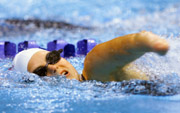|
 Swimming
began as a rehabilitation and leisure activity, but soon
developed into one of the most popular and highly competitive
sports for athletes with a disability. In Swimming competitions
participants are men and women with: a physical
disability or
vision
impairment. Swimming
began as a rehabilitation and leisure activity, but soon
developed into one of the most popular and highly competitive
sports for athletes with a disability. In Swimming competitions
participants are men and women with: a physical
disability or
vision
impairment.
 Athletes
with vision impairment, depending on the degree of vision loss,
are classified into the following categories:
S11-SB11-SM11, S12-SB12-SM12 and S13-SB13-SM13. Athletes
with vision impairment, depending on the degree of vision loss,
are classified into the following categories:
S11-SB11-SM11, S12-SB12-SM12 and S13-SB13-SM13.
For
swimmers with a physical disability, classification is
relatively more complex. Depending on the type of disability,
one first examines the degree of muscle strength, movement
coordination or the scope of movement, and then the functional
ability and movement limitations in the water are assessed in
the various swimming styles. After the above assessment,
athletes are classified into:
|

|
10
classes, S1 - S10, for freestyle, backstroke, and
butterfly
|
|

|
8 classes
for breaststroke, SB2-SB9
|
|

|
8 classes
for the individual medley, SM3-SM10
|
The
greater the functional potential of a swimmer, the higher the
category in which he or she will be classified. A swimmer can be
classified into one class for one swimming style and a different
category for another. Eg., S5 in freestyle, SB4 or SB3 in
breaststroke and SM5 or SM4 in the individual medley. Through
this system of classification, athletes with a different type of
disability can be classified into the same category as long as
they have a similar or almost similar functional ability.
Swimming
at the 2004 Paralympic Games
The
Swimming events will take place at the indoor pool of the
Olympic
Aquatic Centre
of the Athens Olympic Sports Complex (OCO).
The competition programme will be completed in 9 days, from 19
to 27 September 2004. The Paralympic Games programme includes
seven individual events and two relays for every men's and
women's category.
|








 Athletes
with vision impairment, depending on the degree of vision loss,
are classified into the following categories:
S11-SB11-SM11, S12-SB12-SM12 and S13-SB13-SM13.
Athletes
with vision impairment, depending on the degree of vision loss,
are classified into the following categories:
S11-SB11-SM11, S12-SB12-SM12 and S13-SB13-SM13.